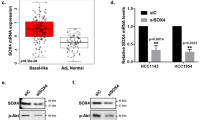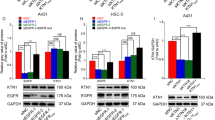Abstract
CYLD is a deubiquitination enzyme that regulates different cellular processes, such as cell proliferation and cell survival. Mutation and loss of heterozygosity of the CYLD gene causes development of cylindromatosis, a benign tumour originating from the skin. Our study shows that CYLD expression is dramatically downregulated in basal cell carcinoma (BCC), the most common cancer in humans. Reduced CYLD expression in basal cell carcinoma was mediated by GLI1-dependent activation of the transcriptional repressor Snail. Inhibition of GLI1 restored the CYLD expression-mediated Snail signaling pathway, and caused a significant delay in the G1 to S phase transition, as well as proliferation. Our data suggest that GLI1-mediated suppression of CYLD has a significant role in basal cell carcinoma progression.
This is a preview of subscription content, access via your institution
Access options
Subscribe to this journal
Receive 50 print issues and online access
$259.00 per year
only $5.18 per issue
Buy this article
- Purchase on Springer Link
- Instant access to full article PDF
Prices may be subject to local taxes which are calculated during checkout




Similar content being viewed by others
References
Altaba AR, Sanchez P, Dahmane N . (2002). Gli and hedgehog in cancer: tumours, embryos and stem cells. Nat Rev Cancer 2: 361–372.
Bignell GR, Warren W, Seal S, Takahashi M, Rapley E, Barfoot R et al. (2000). Identification of the familial cylindromatosis tumour-suppressor gene. Nat Genet 25: 160–165.
Buonamici S, Williams J, Morrissey M, Wang A, Guo R, Vattay A et al. (2010). Interfering with resistance to smoothened antagonists by inhibition of the PI3K pathway in medulloblastoma. Sci Transl Med 2: 51ra70.
Epstein EH . (2008). Basal cell carcinomas: attack of the hedgehog. Nat Rev Cancer 8: 743–754.
Fiaschi M, Rozell B, Bergstrom A, Toftgard R . (2009). Development of mammary tumors by conditional expression of GLI1. Cancer Res 69: 4810–4817.
Grachtchouk M, Rong M, Yu S, Zhang XY, Sasaki H, Hui CC et al. (2000). Basal cell carcinomas in mice overexpressing Gli2 in skin. Nat Genet 24: 216–217.
Jeong J, Mao J, Tenzen T, Kottmann AH, McMahon AP . (2004). Hedgehog signaling in the neural crest cells regulates the patterning and growth of facial primordial. Genes Dev 18: 937–951.
Karhadkar SS, Bova GS, Abdallah N, Dhara S, Gardner D, Maitra A et al. (2004). Hedgehog signalling in prostate regeneration, neoplasia and metastasis. Nature 431: 707–712.
Kasper M, Regi G, Frischauf AM, Aberger F . (2006). GLI transcription factors: mediators of oncogenic hedgehog signaling. Eur J Cancer 42: 437–445.
Kasper M, Regl G, Eichberger T, Frischauf AM, Aberger F . (2007). Efficient manipulation of hedgehog/GLI signaling using retroviral expression systems. Methods Mol Biol 397: 67–78.
Kenney AM, Rowitch DH . (2000). Sonic hedgehog promotes G(1) cyclin expression and sustained cell cycle progression in mammalian neuronal precursors. Mol Cell Biol 20: 9055–9067.
Li X, Deng W, Lobo-Ruppert SM, Ruppert JM . (2007). Gli1 acts through Snail and E-cadherin to promote nuclear signaling by beta-catenin. Oncogene 26: 4489–4498.
Li X, Deng W, Nail CD, Bailey SK, Kraus MH, Ruppert JM et al. (2006). Snail induction is an early response to Gli1 that determines the efficiency of epithelial transformation. Oncogene 25: 609–621.
Louro ID, Bailey EC, Li XN, South LS, McKie-Bell PR, Yoder BK et al. (2002). Comparative gene expression profile analysis of GLI and c-MYC in an epithelial model of malignant transformation. Cancer Res 62: 5867–5873.
Massoumi R . (2010). Ubiquitin chain cleavage: CYLD at work. Trends Biochem Sci 35: 392–399.
Massoumi R, Chmielarska K, Hennecke K, Pfeifer A, Fassler R . (2006a). Cyld inhibits tumor cell proliferation by blocking Bcl-3-dependent NF-kappaB signaling. Cell 125: 665–677.
Massoumi R, Kuphal S, Hellerbrand C, Haas B, Wild P, Spruss T et al. (2009). Down-regulation of CYLD expression by Snail promotes tumor progression in malignant melanoma. J Exp Med 206: 221–232.
Massoumi R, Podda M, Fassler R, Paus R . (2006b). Cylindroma as tumor of hair follicle origin. J Invest Dermatol 126: 1182–1184.
Moriwaki K, Tsuruta D, Sugawara K, Kobayashi H, Massoumi R, Ishii M . (2007). A role of CYLD in hair cycling mouse. J Invest Dermatol 127: S107–S107.
Nilsson M, Unden AB, Krause D, Malmqwist U, Raza K, Zaphiropoulos PG et al. (2000). Induction of basal cell carcinomas and trichoepitheliomas in mice overexpressing GLI-1. Proc Natl Acad Sci USA 97: 3438–3443.
Nitzki F, Zibat A, König S, Wijgerde M, Rosenberger A, Brembeck FH et al. (2010). Tumor stroma-derived Wnt5a induces differentiation of basal cell carcinoma of Ptch-mutant mice via CaMKII. Cancer Res 70: 2739–2748.
Regl G, Kasper M, Schnidar H, Eichberger T, Neill GW, Ikram MS et al. (2004). The zinc-finger transcription factor GLI2 antagonizes contact inhibition and differentiation of human epidermal cells. Oncogene 23: 1263–1274.
Regl G, Neill GW, Eichberger T, Kasper M, Ikram MS, Koller J et al. (2002). Human GLI2 and GLI1 are part of a positive feedback mechanism in basal cell carcinoma. Oncogene 21: 5529–5539.
So PL, Langston AW, Daniallinia N, Hebert JL, Fujimoto MA, Khaimskiy Y et al. (2006). Long-term establishment, characterization and manipulation of cell lines from mouse basal cell carcinoma tumors. Exp Dermatol 15: 742–750.
Von Hoff DD, LoRusso PM, Rudin CM, Reddy JC, Yauch RL, Tibes R et al. (2009). Inhibition of the hedgehog pathway in advanced basal-cell carcinoma. N Engl J Med 361: 1164–1172.
Wickstrom SA, Masoumi KC, Khochbin S, Fassler R, Massoumi R . (2010). CYLD negatively regulates cell-cycle progression by inactivating HDAC6 and increasing the levels of acetylated tubulin. Embo J 29: 131–144.
Yang SH, Andl T, Grachtchouk V, Wang AQ, Liu JH, Syu LJ et al. (2008). Pathological responses to oncogenic hedgehog signaling in skin are dependent on canonical Wnt/beta3-catenin signaling. Nat Genet 40: 1130–1135.
Yauch RL, Dijkgraaf GJ, Alicke B, Januario T, Ahn CP, Holcomb T et al. (2009). Smoothened mutation confers resistance to a hedgehog pathway inhibitor in medulloblastoma. Science 326: 572–574.
Acknowledgements
We thank Rudolf Jung and Elise Nilsson for excellent technical assistance, Dr Anders Edsjö, for discussion, Dr Ervin H Epstein for the mouse BCC cell line ASZ001 and CSZ-1. This work was supported by the Swedish Society for Medical Research, Swedish Cancer Foundation, Swedish Medical Research Council, Crafoordska Foundation, Royal Physiographic Society in Lund, Gunnar Nilsson Cancer Foundation, U-MAS Research Foundations and ERC grant to RM and the Austrian Science Fund FWF (projects P20652), the priority program of the University of Salzburg and the Austrian Genome program Gen-AU to FA.
Author information
Authors and Affiliations
Corresponding author
Ethics declarations
Competing interests
The authors declare no conflict of interest.
Additional information
Supplementary Information accompanies the paper on the Oncogene website
Supplementary information
Rights and permissions
About this article
Cite this article
Kuphal, S., Shaw-Hallgren, G., Eberl, M. et al. GLI1-dependent transcriptional repression of CYLD in basal cell carcinoma. Oncogene 30, 4523–4530 (2011). https://doi.org/10.1038/onc.2011.163
Received:
Revised:
Accepted:
Published:
Issue Date:
DOI: https://doi.org/10.1038/onc.2011.163
Keywords
This article is cited by
-
Discovery of a small molecule that inhibits Bcl-3-mediated cyclin D1 expression in melanoma cells
BMC Cancer (2024)
-
Potential use of EGFR-targeted molecular therapies for tumor suppressor CYLD-negative and poor prognosis oral squamous cell carcinoma with chemoresistance
Cancer Cell International (2022)
-
Protein arginine methyltransferase 1 interacts with Gli1 and regulates its transcriptional activity
Tumor Biology (2016)
-
Early diagnostic value of Bcl-3 localization in colorectal cancer
BMC Cancer (2015)
-
MicroRNA-362 induces cell proliferation and apoptosis resistance in gastric cancer by activation of NF-κB signaling
Journal of Translational Medicine (2014)



